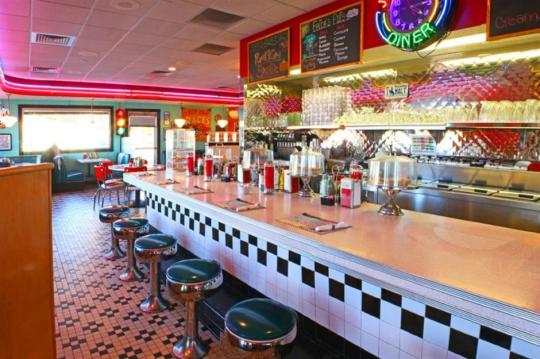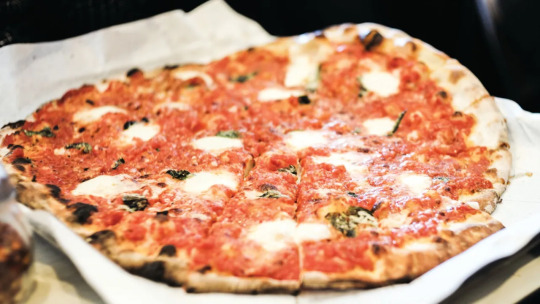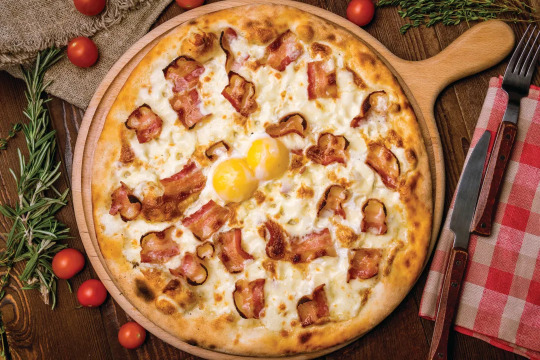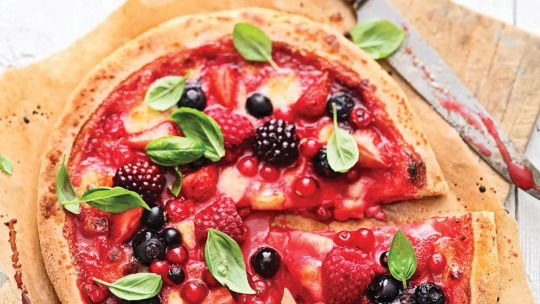#Philadelphia Hawaiian food
Explore tagged Tumblr posts
Text
Mahalo Hawaiian BBQ to Open on South Street
Are you craving a delicious and satisfying meal that transports you to Hawaii islands? Good news! Ivy Cheng, the owner of “Jade Fashion Boutique” located at 250 South Street, next to Nora’s Tacos, will open Mahalo Hawaiian BBQ at 117 South Street in mid-August. Mahalo, which means “Thank You” in Hawaiian, the new Hawaiian BBQ eatery in the Headhouse District will open its doors in the former…

View On WordPress
0 notes
Text
Discover America’s Best Flavors: 10 Must-Try Dishes!

When it comes to culinary diversity, the United States offers a mouthwatering array of dishes that reflect its rich cultural mosaic. From coast to coast, every region boasts its own signature flavors, making the country a paradise for food lovers. To truly taste the flavors of America, one must embark on a gastronomic journey that includes these ten must-try dishes, each representing the unique essence of its place of origin.
1. New York Pizza
New York City's pizza is legendary for its thin, foldable crust and perfectly balanced toppings. Whether you grab a slice from a street vendor or sit down at a renowned pizzeria like Di Fara, experiencing the city's pizza culture is a must for any food enthusiast.
2. Southern Fried Chicken
The South is synonymous with fried chicken, a dish that is crispy on the outside, juicy on the inside, and bursting with flavor. Visit establishments like Gus’s World Famous Fried Chicken in Tennessee to savor this comfort food at its finest.
3. Texas Barbecue
Texas takes barbecue to an art form, with smoked meats that are cooked low and slow to perfection. Head to Franklin Barbecue in Austin for brisket that melts in your mouth and sausages that pack a punch.
4. New England Clam Chowder
A visit to New England isn't complete without a bowl of creamy, hearty clam chowder. The Union Oyster House in Boston serves up this iconic dish, filled with tender clams, potatoes, and a savory broth.
5. Chicago Deep-Dish Pizza
In stark contrast to its New York counterpart, Chicago's deep-dish pizza features a thick, buttery crust filled with layers of cheese, toppings, and chunky tomato sauce. Lou Malnati's Pizzeria is a local favorite for this indulgent treat.
6. Louisiana Gumbo
Gumbo, a rich stew from Louisiana, combines the flavors of the region’s French, Spanish, and African influences. Sample a bowl at Commander’s Palace in New Orleans, where seafood, sausage, and okra meld into a deliciously complex dish.
7. San Francisco Sourdough Bread
San Francisco’s sourdough bread, known for its tangy flavor and chewy texture, is a must-try. Boudin Bakery has been serving up this classic since 1849, offering a taste of history along with every bite.
8. Philadelphia Cheesesteak
The cheesesteak, a sandwich loaded with thinly sliced beefsteak and melted cheese, is a Philadelphia staple. Pat’s King of Steaks and Geno’s Steaks, located across the street from each other, are two iconic spots to try this beloved dish.
9. Hawaiian Poke
For a taste of the islands, dive into a bowl of poke, a Hawaiian dish featuring fresh, marinated raw fish. Ono Seafood in Honolulu is renowned for its authentic and flavorful poke bowls, which capture the essence of Hawaiian cuisine.
10. Seattle’s Coffee Culture
While not a dish, Seattle’s coffee culture is an integral part of the city's identity. Visit the original Starbucks or any of the city’s numerous artisanal coffee shops to experience the rich, robust flavors that have made Seattle a coffee lover’s haven.
Conclusion
From savory to sweet, spicy to mild, the United States offers an unparalleled culinary adventure. To truly taste the flavors of America, indulge in these ten must-try dishes that showcase the nation's diverse and delicious heritage. Each bite is a journey through the heart and soul of American culture, promising a feast for the senses that you won't soon forget.
0 notes
Text

(Sorry as I'm a week late, as this was originally intended to be posted on May 1, 2024)
Anyways, this month Ethan Cross Media is celebrating Asian-American, Native Hawaiian, and Pacific Islander Heritage Month! 😀
I'm proud to be an American person of Filipino descent who creates arts and entertainment content and designs original and third party intellectual property characters. Born from parents who are from the Philippines in the United States. I know you guys, if you live in larger American metropolitan areas like here in Chicago, Los Angeles, New York City, Washington, D.C., Dallas, Seattle, Las Vegas, Philadelphia, and many others, where it has Filipino population, you might be familiar with Jollibee (a Filipino fast food chain).
1 note
·
View note
Text
Thoughts While Watching Gilmore Girls, S1/Ep5 ("Cinnamon's Wake")
What Happens In This Episode: Dean Forrester's parents regret having unprotected sex 16 years earlier. Miss Patty tells Rory that plums are better than sex, giving Rory the most comprehensive sex ed lesson she's had thus far in her life. Lorelai agrees to a date with Max and Rory finds out. Babette's cat Cinnamon tragically passes on, and the town attends the wake. Dumbass Dean is in the Netflix thumbnail for the episode. Just fantastic.

Cinnamon, an Icon.

IMPENDING DOOM. American Horror Story:






Look, I'm not saying Dean Forrester fans (or even just people who think he's OKAY) don't exist (my best friend is one, sigh, and my other best friend is a LOGAN stan..where did I go wrong)...but, anyway, I don't know how to end that sentence. While the Jess vs Logan debate will go on until the end of time, this fandom does unilaterally agree on one thing: Dean is a garbage person. I think thats beautiful.

In about four years you will choose to lose your virginity to this man, who also somehow convinced another girl to marry him. What kind of evil powers does he wield?

That scene was unspeakably creepy! I need a shower! I feel unclean.

Me protecting Jess Mariano at all costs.

Life in Stars Hollow is so vibrant and exciting. Rory question's Lane dream of moving to Philadelphia, asking "What would you do there?" Oh Rory, give it about 6 years and there will be something to "do" in Philadelphia.

I have a new hobby. Looking out for the real brand names and made up ones in this show. This one's got a feast of authentic brand names. I counted 8. Can you find them all? (answers at bottom of post) It feels kind of scandalous that you can buy pregnancy tests in Stars Hollow. I think half the town still thinks the stork delivers babies. Taylor Doose definitely does.

Well, Rory's first time having sex is with Dean, so Miss Patty isn't wrong. Miss Patty is such a pervert and I relate to her.

Kirk's Jobs So Far: DSL Installer, Swan Delivery Boy, Grocery Store Assistant Manager. Reading his nametag, Mick is now officially Kirk. Kirk to MIss Patty who is sampling produce: "I assume you're going to pay for the food that you've consumed?" Where do you think you are, Kirk? Nobody in Stars Hollow pays for anything they eat.

How nice of Dean to ask what kind of sack I'd like to stuff him in before throwing him over a fence.


Cinnamon, we hardly knew ye.

Just put the sodas down here. Easy now. Now slowly back away. Over a cliff.

Alexis often legitimately looks terrified of Jared and I can't always tell how much of it is acting (yes, I am aware they sort of dated at one point).

The one and only!

That's right, we have yet to meet Taylor Doose. "The Owner". The ol Money Launderer himself. We haven't had a Town Meeting yet, either.

Disturbing.

No man can tame her.

Babette's a perv too. I love both of these Queens.

Babette apparently has a lot of gnomes. How did she even know when one was kidnapped?

I'm sensing a recurring theme here.

The most fateful three words to ever come out of Rory's mouth: "I am interested." She is doomed.

Another cursed image. The Good: Babette and Miss Patty being pervs, Cinnamon the cat. The Bad: Creepy Forrester. Cinnamon dies. The Meh: Lorelai goes on a date with Max Medina. Max will always end up in the "meh" column. Real Brands Sold At Doose's Market: Hawaiian Punch, Iams Dog Food, Stayfree Pads, Apple Jacks, Pepcid, Planters Cheese Puffs, Sugar Smacks, 7-Up.
#Anti Dean Forrester#Dean Forrester Sucks#Dean Forrester is Creepy#Gilmore girls#Lorelai Gilmore#Rory Gilmore#Miss Patty#Max Medina#Denise Rewatches Gilmore Girls#Gilmore Girls Season 1#Cinnamons Wake
25 notes
·
View notes
Text
#News you might have missed during the week:
#LosAngeles/#LA County Supervisors have banned feeding #peacocks in #EastPasadena after residents complained it fanned the flames of a #peafowl invasion. https://www.npr.org/2021/06/21/1008656307/california-county-bans-the-feeding-of-peacocks-in-east-pasadena
Twyanna Williams dropped out of #highschool when she was just 15 years old so she could help her mom pay the bills, but she never stopped wanting to go back to #school. Now, 50 years later, the 65-year-old #Philadelphia grandmother isn't just graduating, she is valedictorian. #education https://www.npr.org/2021/06/21/1008656314/philadelphia-grandmother-graduates-high-school-50-years-after-she-dropped-out
#FantasyFootball Loser Is Forced To Spend 24 Hours At A #WaffleHouse. https://www.npr.org/2021/06/22/1008986936/fantasy-football-loser-is-forced-to-spend-24-hours-at-a-waffle-house
British Man Breaks #GuinnessRecord for M&M Stacking. https://www.npr.org/2021/06/23/1009339852/british-man-breaks-m-m-stacking-record
When an Eel Climbs a Ramp to Eat Squid From a Clamp, That's a Moray. https://www.nytimes.com/2021/06/22/science/moray-eels-eat-land.html
A #WashingtonDC woman wore the same Hawaiian shirt to 264 Zoom meetings between April 2020 and this month. https://www.npr.org/2021/06/24/1009750963/d-c-woman-starts-new-job-without-her-well-worn-hawaiian-shirt
#Massachusetts Bar Takes In $1,800 In Fake Money. Ralph's Tavern briefly accepted #Monopoly money in payment for the cover charge and food. The tavern is campaigning for a spot on a planned version of the Monopoly game that is #Worchester-themed. https://www.npr.org/2021/06/24/1009751007/massachusetts-bar-takes-in-1-800-in-fake-money
Dave Robles, an elementary school #teacher from #NewYorkCity #NYC, uses rap beats to help his students learn #grammar lessons. https://www.npr.org/2021/06/25/1010176528/new-york-teacher-drops-sick-beats-for-grammar-lessons
Professional runner, Rebecca Mehr, is competing in the U.S. #Olympics trials. She also loves #cheese. Her boyfriend sent some tweets on her behalf, and now she's inundated with cheesy sponsorship requests. #sports https://www.npr.org/2021/06/25/1010176549/olympic-runner-scores-cheesy-sponsors-after-sending-a-tweet
#Twitter Helps Photographer Find Couple She Took Unexpected Engagement Photos For. #photography https://www.npr.org/2021/06/25/1010176598/twitter-helps-photographer-find-couple-she-took-unexpected-engagement-photos-for
22 notes
·
View notes
Photo

Loco Moco at Poi Dog (Philadephia, PA).
14 notes
·
View notes
Text
I got tagged by Dez @e-dykes to do an ask thing!
Name: Celyn, but if you wanna throwback I also go by Bee/Bea and Lanira!
Nicknames: I don’t have any really, but if you wanna give me one I’m all ears!!
Zodiac Sign: Taurus Sun AND Moon. No idea what the other ones are
Height: 6′0
What time is it?: 8:22 pm
Favorite Musician(s): Honestly I don’t really follow specific artists, but the two exceptions are Jimmy Buffett and Hozier so.
Favorite Sports Teams: I don’t really follow sports, but when I was a kid I just sorta chose Philadelphia to make it easier to answer questions like this
Other blogs?: My other main one I use is @pride-icon-please where I make pride icons!
Do I get asks?: No!! It’s disappointing cause I really like getting them :<
How many blogs do I follow?: So fuckin many bro
Any tumblr crushes?: Everyone tagged in this post ;)
Lucky Number: I don’t really have one tbh
What I’m wearing rn: A really soft t-shirt with a hawaiian shirt sorta pattern and jeans
Drink of choice: Hot chocolate, coffee, or specialty soda!! Love the fruity flavored sodas (FUCK fanta tho)
Dream Car: The 1958 Lincoln Continental Mark III
Dream Vacation: A long and very specific trip to visit a bunch of internet friends!!
Favorite food: I fuckin love pineapple, so anything with pineapple is fuckin supreme
Instruments: I wish I could play electric bass and piano!! I took cello for 2 years in 3rd and 4th grade but I can’t remember any of it
Celebrity crushes: All 4 Mcelroys, but in different ways
Random fact: I wanna be a linguist!! I fuckin love languages and I’m currently learning Dutch and Spanish!
I’m tagging @gncfag, @dartfrogs, @transastra, @transrightstorchic, and all my other mutuals!!
4 notes
·
View notes
Link
USA is a trusted name amongst both vacation and business travelers. It also involves a lot of expenditure on various fronts. We at Matrix can help you in our own way by offering what we do best. Our SIM cards offer complete travel solutions, with the tips for travelling to USA and also how to take best advantage of various Matrix SIM cards in that country.
Matrix SIM Card - USA Travel Tips
Matrix SIM card takes care of its card holders and provides supports, tips and help during the journey. We provide you with the best tips for travel to USA and also how to take the best advantage of various Matrix SIM cards there.
The United States is a country that demands more time to see. There are lot of national parks, a diverse geography, culture, music, and great regional food. United States vacation spots are as diverse as the country's landscape -- the glitz of Las Vegas, the rich culture of New Orleans, the tropical beaches of Hawaii and the majestic beauty of the Grand Canyon, one of the best national parks in the world.
Geography:
The land area of the contiguous United States is 7,663,941 square kilometres. Alaska, separated from the contiguous United States by Canada, is the largest state at 1,717,856 square kilometres. Hawaii, occupying an archipelago in the central Pacific, southwest of North America, is 28,311 square kilometres in area. The United States is the world's third largest nation by total area (land), ranking behind Russia and China.
Country Climate:
The United States, with its large size and geographic variety, includes most climate types. To the east of the 100th meridian, the climate ranges from humid continental in the north to humid subtropical in the south. The southern tip of Florida is tropical, as is Hawaii. The Great Plains west of the 100th meridian are semi-arid. Much of the Western mountains are alpine. The climate is arid in the Great Basin, desert in the Southwest, Mediterranean in coastal California, and oceanic in coastal Oregon and Washington and southern Alaska. Most of Alaska is subarctic or polar.
Official Language:
English is the de facto national language. Although there is no official language at the federal level, some laws—such as U.S. naturalization requirements—standardize English. Some Americans advocate making English the country's official language, as it is in at least twenty-eight states. Both Hawaiian and English are official languages in Hawaii by state law.
Country Currency:
United States dollar ($) (USD)
Major Cities:
New York
Los Angeles
Chicago
Dallas
Houston
Philadelphia
Washington, D.C.
Miami
Atlanta
Boston
The country code for the USA is 1 and the international call prefix is 00.
Major Attractions (Travellers/Students):
The United States is a country that demands more time to see. There are lot of national parks, a diverse geography, culture, music, and great regional food.
United States vacation spots are as diverse as the country's landscape -- the glitz of Las Vegas, the rich culture of New Orleans, the tropical beaches of Hawaii and the majestic beauty of the Grand Canyon, one of the best national parks in the world.
Five must-visit tourist attractions in USA:
Arches, Utah
Brooklyn Bridge
Yellowstone, Wyoming, Montana & Idaho
Niagara Falls
Grand Canyon
#Arches Utah#Brooklyn Bridge#Niagara Falls#Grand Canyon#Yellowstone Wyoming Montana & Idaho#Travellers#Students#Matrix SIM card#international sim cards
2 notes
·
View notes
Text
Where to Eat in Dillsburg, PA

Dillsburg is the ultimate small town with no traffic lights, fast food chains or big box stores to be found — instead, you will find charming restaurants that serve up genuine food and fun. It may be located within a two-hour drive of Philadelphia, but Dillsburg is worlds away from it in its charm and hospitality. Here is a brief guide to some of the best restaurants in Dillsburg.
Wolfe's Diner
Wolfe's Diner is a popular restaurant and bar with a casual, diner-style ambiance. The restaurant offers a wide variety of breakfast, lunch, and dinner options, as well as an extensive drink menu. Wolfe's Diner also has a large outdoor patio with live music on weekends.
Wolfe's Diner is located on Main Street in Dillsburg, Pennsylvania. The restaurant has been open since 1956 and features a classic American menu with lots of diner favorites like burgers, sandwiches, and wraps.
The menu at Wolfe's Diner has something for everyone, including breakfast all day long (including pancakes), lunch classics like steak sandwiches and Philly cheesesteaks, and dinner options like chicken parmesan or spaghetti with meatballs.
Wolfe's Diner also has an extensive drinks menu that includes beer on tap, wine by the glass or bottle, mixed drinks such as martinis or margaritas, as well as non-alcoholic beverages like sodas and milkshakes.
Wolfe's Diner is family-friendly with two levels: the main level features booths and tables while the upper level has more seating options for larger parties or for those who want to watch games on TV
The Dairy Barn
The Dairy Barn is a great place for families with kids. There are picnic tables and grassy areas for kids to run around. There is also a playground, but it is not very big and can get crowded quickly. The food at The Dairy Barn is pretty good, but it can be very expensive if you are not careful. The service can be slow, so be prepared to wait on your food.
If you visit The Dairy Barn during the summer months, they offer milkshakes made with real ice cream! The milkshakes are fantastic! They have many different flavors and sizes to choose from. If you have never had an ice cream milkshake before, this is the place to try one!
The Dairy Barn has been around since 1952 and has been owned by the same family since then. They have known for their homemade ice cream as well as their fried foods like funnel cakes, french fries, onion rings, etc.
Bert's Pizza
Bert's Pizza is a family-friendly, casual restaurant in Dillsburg, Pennsylvania. Bert's Pizza has been serving the community since 1968. Bert's Pizza serves up delicious pizza, pasta, salads, and sandwiches. They also have a large selection of beer on tap and in bottles. The menu at Bert's Pizza is reasonably priced and they offer takeout as well as delivery services. Their menu includes items such as:
Pizza - Bert's Pizza has a large variety of pizzas including pepperoni pizza, cheese pizza, sausage pizza, Hawaiian pizza, and more!
Pasta - Bert's Pizza offers a variety of pasta including spaghetti with meatballs or chicken alfredo pasta for those who want something more than just regular noodles with tomato sauce!
Sandwiches - Bert's Pizza offers several different kinds of sandwiches including Philly cheesesteak sandwiches, chicken parmesan sandwiches, and even hot dog options!
Salads - If you're looking for something lighter than your typical Italian fare then Bert's Pizza has several salad options to choose from including chicken Caesar salad, Greek salad, and more!
Baker's Diner
When you're in the mood for good times and great cuisine, be sure to check out Baker's Diner. The restaurant is located in one of the area's most pleasant settings and is known for its delightful staff and superb cuisine. The menu at Baker's Diner features a wide array of great selections, made from only the freshest and highest quality ingredients, with something sure to please every member of your group. In addition to its convenient take-out menu, this restaurant also offers delivery, and can even cater events in the area. Whether you're a local looking for a delicious meal or simply passing through the area, a trip to Baker's Diner is definitely worth your while!
Baker's Diner is located near many parking lot options as well as street parking. For those who prefer to travel by bike, Baker's Diner is a great option due to its generous bike parking options.
Tom's Diner
Tom's Diner is a great place to grab a bite to eat when you're in the Dillsburg area.
Tom's Diner serves breakfast all day long, which is great for those who have an early morning or late night shift and want to get some grub before hitting the road. It has been a staple of the community for years, so locals know that it's a good place to go for some comfort food.
The diner has a retro vibe with its booths and jukebox, but it also features modern amenities like free Wi-Fi and a big-screen TV that plays sports games on weekends. The restaurant offers plenty of seating options, including booths and tables, so you can choose where you want to sit based on your mood at the time.
The menu includes sandwiches and burgers as well as other lunch items like salads and soups. There are also several specialty burgers available that come with toppings like cheese sauce or mushrooms.
If you're looking for breakfast options, Tom's Diner has plenty of those too! The menu includes pancakes, waffles, and French toast along with other breakfast staples like omelets and hash browns.
Takeaway: If you're looking for a great evening out in a small town, look no further than Dillsburg. There are a variety of restaurants to choose from and something for everyone here. Whether you live in the area or are visiting the town for the first time, you can't go wrong with any of the restaurants listed above.
Are you looking for a Roofing Contractor in Dillsburg, Pennsylvania?
You've come to the right place. At Dreamworx Exteriors, we're proud to offer high-quality residential and commercial roofing services to the greater Dillsburg area. Our team of experienced professionals is fully licensed and insured, so you can count on us to do the job right the first time.
We provide a wide range of roofing services including roof replacement Dillsburg and maintenance, Re-roofing, Leak repair, Roof installation (shingles and metal), And more!
Dreamworx Exteriors Dillsburg 717-502-4214 https://dreamworxexteriors.com/
0 notes
Text
A slice of the pie: October is National Pizza Month

New Haven Pizza (recipe at https://bit.ly/3El23tlNew Haven style pizza generally does not include a layer of melted mozzarella on top, allowing the tomato sauce to shine.(Photo courtesy of Cider Mill Press Book Publishers, LLC)
Check out my latest column
https://www.timesherald.com/2022/10/06/a-slice-of-the-pie-october-is-national-pizza-month/
Need a reason to indulge in carbs? It’s National Pizza Month. Pizza deserves a celebration, being the most Instagrammed food worldwide, according to a study commissioned by Chef Alessio Mecozzi. You might have thought beautifully decorated cupcakes or sushi (#2) would have reigned supreme on Instagram. What is interesting is that six percent of the photos of pizza were posted by New York City pizza aficionados and only two percent were posted by Instagrammers in Italy.
Pizza is big business, having an international trade show, “Pizza Expo” and a trade magazine “Pizza Today.” We have Gerry Durnell (1942-2011), the founder of the magazine and trade show, to thank for the month’s celebration. Why October? It was in October of 1984 when the magazine debuted. Then, in 1987 the U.S. Congress officially designated October as National Pizza Month. The current issue pays homage to National Pizza Month – where it says, “The Northeast has the highest concentration of pizzerias and Italian restaurants in the U.S.”
How do you score on your pizza knowledge? (answers are below)
1. What is the most most popular pizza topping in the United States?
A. Mushrooms
B. Onions
C. Pepperoni
D. Sausage
2. What is the oldest, continuously-operated pizzeria in the United States?
A. Tacconelli’s Pizzeria (located in Philadelphia,, PA)
B. Papa’s Tomato Pies (located in Trenton, NJ)
C. Patsy’s Pizzeria (New York, NY)
D. Frank Pepe Pizzeria Napolitana (located in New Haven, CT)
3. Which of the following condiments is common for the Japanese to put on their pizza?
A. Ketchup
B. Mayonnaise
C. Mustard
D. Sesame seed oil
4. Among the ingredient on a classic Hawaiian pizza are ham, and pineapple. Where was this style of pizza invented?
A. Canada
B. Chicago
C. Hawaii
D. New York
5. What are the five basic ingredients in pizza dough?
A. Flour, milk, yeast, vinegar, oil
B. Flour, milk, yeast, sugar, oil
C. Flour water yeast, baking soda, butter
D. Flour, water yeast sugar, oil
6. The Museum of Pizza Culture is in
A. Miami, FL
B. New York City
C. New Haven, CT
D. Philadelphia, PA
7. What pizza-making technique has it’s a professional-level competition?
A. Dough-spinning
B. Ingredient-placing
C. Sauce-spreading
D. Taste-testing
8. A pizza topping first used by Frank Pepe Pizzeria Napoletana in New Haven, CT and very poplar is
A. Lobster
B. Clams
C. Calamari
D. oysters
Answers to questions
1. C 2. B 3. B 4. A 5. D 6. D 7. A 8. B
I hope you didn’t get number 6 wrong!
New Haven, CT has been my home for almost four decades, and one thing that has not changed is the question I am often asked by visitors…What is the best place for pizza in New Haven, Sally’s or Pepe’s. Both are legendary pizzerias, well-known throughout the U.S. and beyond. Of course, when I moved to New Haven it was a must to wait on the long lines to get a table at these famous establishments. Now, when I pass by their restaurants on historic Wooster Street in New Haven’s Little Italy, I say to myself they must be tourists or recently moved to the area. Over the years, I have come to find the pies at Modern and BAR just as good minus the long lines. Of course, that is only my opinion. Truth be told, as a native New Yorker, I still think pizza is best in “the city.”
I can bet in your area, there is the debate as to what pizza is the best around town. Please let me know, so when I next visit Greater Philadelphia, I’ll know where to go for the best pizza.
Of course, each of us have a favorite style…Neapolitan, Chicago, New York Style, Sicilian, Greek, California, Detroit, St. Louis, New Haven-style apizza (pronounced ah-beets by many locals)
Whatever the type of crust (thin or thick) or style of pizza, the sky is the limit as to the ingredients to make pizza. The artisan pies created today fit the bill for many, but if you are like me, I am a traditionalist when it comes to pizza. I will leave the sriracha sauce, apples and goat cheese, blue cheese and pumpkin to dishes other than pizza. I must admit though, the mashed potato and bacon pizza served at BAR in New Haven is an exception!
If you have joined or thinking about joining the home pizza making craze check out “Pizza: The Ultimate Cookbook,” by Barbara Caracciolo (2020 Cider Mill Press,$35) . From backyard wood-fired pizza ovens to electric portable pizza ovens for the kitchen to equipment to make crispy pies in your traditional oven, the book will become your go-to for recipes (there are more than 300!) that will capture your taste buds and provide inspiration. Before getting to the recipes, the author writes about the history of pizza and in-depth discussions about the various styles of pizza. I learned what the difference is between New Haven-style and New York-style pizza. She writes, “The biggest difference when compared to New York pizza is the omission of low-moisture mozzarella cheese. The best New Haven pizzas let the sauce shine, so much in fact they are often called tomato pie. In New Haven, mozzarella is considered a topping rather than a key component.”
The Perfect Pie chapter gives details about ingredients and equipment. The recipes for doughs (no-knead as well) for both pizza and focaccia are plentiful. The photos bring the slices to life. Now, let’s get rolling the dough with these recipes from the book. For these recipes, I’ve shared the authors’ Quick Pizza Dough recipe. There are many others to choose from. For the New Haven pie go to https://bit.ly/3El23tl

Eggs & Bacon Pizza Cold leftover pizza is always a great breakfast option, but this pie does it one better. (Photo courtesy of Cider Mill Press Book Publishers, LLC)
Pizza with Eggs & Bacon
Yield: 1 Pizza / Active Time: 15 Minutes / Total Time: 45 Minutes
The headnote says, “Cold leftover pizza is always a great breakfast option, but this pie does it one better.”
Semolina flour, as needed
1 ball pizza dough
3 ½ ounces (100 grams) low-moisture mozzarella cheese, shredded
2.4 ounces. (70 grams) bacon, cooked and chopped
2 eggs
Salt and pepper, to taste
Olive oil, as needed
Preheat the oven to the maximum temperature and place a baking stone or steel on the middle rack as it warms. Dust a work surface with the semolina flour, place the dough on the surface, and gently stretch it into a round. For more detailed instructions on properly stretching a ball of pizza dough see page 73 in the book. Cover the dough with the mozzarella and top with the bacon. Crack the eggs open onto the center of the pizza, season with salt and pepper, and drizzle olive oil over the top.
Using a peel or a flat baking sheet, transfer the pizza to the heated baking implement in the oven. Bake for about 15 minutes, until the crust is golden brown and starting to char. Remove and let cool slightly before slicing and serving.

Avocado, Tomato & Feta Pizza (Photo courtesy of Cider Mill Press Book Publishers, LLC)
Avocado, Tomato & Feta Pizza
Yield: 1 Pizza / Active Time: 15 Minutes / Total Time: 45 Minutes
Semolina flour, as needed
1 ball pizza dough
1.4 ounces (40 grams) low-moisture mozzarella cheese, shredded
Olive oil, to taste
Flesh of ½ avocado, mashed
½ tomato, diced
1 ¾ ounces (50 grams) feta cheese, crumbled
Salt and pepper, to taste
Preheat the oven to the maximum temperature and place a baking stone or steel on the middle rack as it warms. Dust a work surface with the semolina flour, place the dough on the surface, and gently stretch it into a round. Cover the dough with the mozzarella and drizzle olive oil over the pizza.
Using a peel or a flat baking sheet, transfer the pizza to the heated baking implement in the oven. Bake for about 15 minutes, until the crust is golden brown and starting to char. Remove and let cool slightly before topping with the avocado, tomato, and feta and seasoning with salt, pepper, and a drizzle of olive oil.

This is not a dessert pizza. The strawberry puree stands in for tomato sauce, pairing surprisingly well with the cheese and making for a sweet, sour, and savory flavor experience.(Photo courtesy of Cider Mill Press Book Publishers, LLC)
Mixed Berry Pizza
Yield: 1 Pizza / Active Time: 15 Minutes / Total Time: 45 Minutes
The headnote says, “This is not a dessert pizza. The strawberry puree stands in for tomato sauce, pairing surprisingly well with the cheese and making for a sweet, sour, and savory flavor experience.”
1 ¾ ounces (50 grams) strawberries
Semolina flour, as needed
1 ball pizza dough
2.1 ounces (60 grams) low-moisture mozzarella cheese, shredded
1 ounce (30 grams) raspberries
1 ounce (30 grams) blackberries
1 ounce (30 grams) blueberries
Fresh basil leaves, for garnish
Preheat the oven to the maximum temperature and place a baking stone or steel on the middle rack as it warms. Place the strawberries in a blender and blitz until smooth. Strain the puree to remove the seeds and set aside.
Dust a work surface with the semolina flour, place the dough on the surface, and gently stretch it into a round. Cover the dough with the strawberry puree and top with the mozzarella, raspberries, blackberries, and blueberries.
Using a peel or a flat baking sheet, transfer the pizza to the heated baking implement in the oven. Bake for about 15 minutes, until the crust is golden brown and starting to char. Remove and let cool slightly before garnishing with the basil, slicing, and serving.
Quick Pizza Dough
3 1/3 teaspoons 9.6 grams) active dry yeast OR 2 ½ teaspoons (8 grams) instant yeast
15 ½ ounces (440 grams) water
23.2 ounces (660 grams) bread flour OR “00” flour, plus more as needed
1 tablespoon (17 grams) table salt
Olive oil, as needed
If using active dry yeast, warm 3 ½ tablespoons (1 ¾ ounces/ 50 grams) of the water until it is about 105 degrees. Add the water and yeast to a bowl and gently stir. Let sit for 5 to 10 minutes. Instant yeast does not need to be proofed.
In a large bowl, combine the flour, yeast, and water and work the mixture until it just holds together.
If kneading by hand, transfer dough to a flour dusted surface. Work it until it is smooth and elastic. (The book gives instructions on kneading and mixing on page 71).
Add salt and knead until dough is developed, elastic, and extensible, about 5 minutes. Form dough into a ball and place in a lightly greased airtight container that is at least three times bigger. Let rest in a naturally warm spot (in the oven with light on is a good option) until it has doubled in size, about 1 hour.
Transfer dough to a floured work surface, divide it into four pieces, and shape into balls. Place the rounds in a greased baking dish with high edges, leaving enough space between rounds so that they won’t touch when fully risen. Cover with greased plastic wrap and let rest for 40 minutes to an hour before using to make pizza. Makes 4 balls of dough.
Recipes and photos courtesy of

Stephen Fries, is a newly retired professor and coordinator of the Hospitality Management Programs at Gateway Community College, in New Haven, CT. He has been a food and culinary travel columnist for the past 14 years and is co-founder of and host of “Worth Tasting,” a culinary walking tour of downtown New Haven, CT. He is a board member of the International Association of Culinary Professionals. [email protected] For more, go to stephenfries.com.
0 notes
Text
Welcome to my kitchen!
I’m Joan Black, the founder, chef and developer of KINwagrow, a plant-based food blog. I’m also a mom, wife, Air Force veteran, culinary school graduate, writer and breast cancer survivor.
As far back as I can remember, food has been my obsession. As a teenager, I cooked my way through Betty Crocker cookbooks, and in my twenties, I moved on to Martha Stewart’s Entertaining and Julia Child’s Mastering the Art of French Cooking. Over the years, I became an avid vintage cookbook and magazine collector. Shows like The Galloping Gourmet, East Meets West with Ming Tsai, Cucina Amore and In Julia’s Kitchen with Master Chefs, fed my curiosity and open my eyes to the world of cooking.
Living in Hawaii during part of elementary school, I incorporated food into school projects and eagerly researched native Hawaiian foods as we studied the history of Hawaii. In junior high, I wrote reports on the foods of Peru and Russia for world geography. I performed a comparative nutritional analysis of fresh, canned and frozen green beans for my high school chemistry project.
After earning my biology degree from UNLV, I joined the Air Force and landed in Washington, D.C., and later Philadelphia, where my fascination with food exploded. The food culture on the East Coast was very different from Las Vegas. I took French cooking classes and made puff pastry from scratch. When I ate a great dish at a restaurant, I’d often recreate it at home. I loved picking produce at the farmers’ grocery stands, sampling local fare of county fairs and festivals, and tasting the offerings of historic country bed-and-breakfast inns.
My Air Force buddies shared my love of food. We had weekly themed dinners showcasing foods from different countries. There was the Greek toga party with Ouzo and moussaka and German night with cherries soaked in cherry brandy in the Black Forest cake. We cooked together making fudge, pulled butter mints, French baguettes, and so much more. The best of times!
In 1999, I enrolled in culinary school and decided I wanted to become a chef. From day one, I knew this was where I was supposed to be. I worked as a cook at Commander’s Palace Restaurant Las Vegas. Whether I was creating a roux for béchamel sauce, making gumbo or prepping artichokes, I loved being in kitchen.
After a back injury, I needed a break from the physical demands of the kitchen. Food was still my passion, so I started writing about local restaurants and interviewed celebrity chefs. I also did business writing for magazines, newspapers and marketing agencies. For nearly five years, I owned and operated, The Creative Octopus, LLC, a professional writing firm catering to the needs of small businesses.
My Plant-based Journey
In 2011, a friend introduced me to plant-based cuisine and I read The China Study by T. Colin Campbell. I was intrigued, interested in the health benefits, and wanted to see how I felt eating differently. As I embarked on a new culinary adventure with ingredients I’d never heard of and didn’t know how to use, I was open to new possibilities. What was nutritional yeast, how did you make cheese from nuts, and what was raw cooking? I’ve always loved baking and it proved to be a challenge as I stopped using heavy cream, butter and eggs. I felt lost. Then I learned how to make delectable chocolate mousse, cheesecake and scones without eggs and dairy products. As my confidence grew, I created my own mouthwatering plant-based dishes and revisited the classic cookbooks and magazines that once inspired me—to craft vegan versions of my old recipe favorites.
My perspective shifted. Eating a plant-based diet makes me feel better, have more energy, and now I’ve adopted the ‘way of the vegan’ for the animals as well as the health benefits.
KINwagrow – Welcome to the family!
In December 2016, I was diagnosed with breast cancer. As I went through treatment, I had time to reflect, meditate and think about the next step in my journey. I decided blogging offered the perfect way to share my passion for creative and innovative plant-based food with others.
KINwagrow focuses on simply delicious and decadent plant-based food. It is the foodie haven where you’ll find crave-worthy recipes, healthy eating tips from experts, information about plant-based restaurants, chef interviews and more.
For those dealing with cancer and the effects of its treatment on eating, KINwagrow will serve as a resource center and include interviews with nutritionists, dieticians, physicians and other experts. It is my hope that their suggestions help readers and their loved ones get through this difficult time easier.
I’m so glad you stopped by!
#kinwagrow#plant-based#vegan#food#foodblogger#veganfood#recipes#healthy#nutrition#foodie#foodphotography#foodoftheday#delicious#crave#healthy eating#vegansofig#animalfree#energy#health benefits#juicing#aquafaba
1 note
·
View note
Photo

New Post has been published on https://freenews.today/2021/03/12/the-way-to-his-heart-was-through-his-stomachache/
The Way to His Heart Was Through His Stomachache

Three weeks after Jennifer Camilla Berger and Jesse Prestwood-Taylor began dating in summer 2014 they came down with a bout of food poisoning together. (They blame an avocado).
“My parents are both doctors,” she said. “I know what to do when I feel sick. Rest, hydrate, ibuprofen.”
Her unflappable, kind nature, with the help of Gatorade, came through so clearly during the ordeal that Mr. Prestwood-Taylor fell in love.
In February 2014, a mutual friend introduced them, perfunctorily, in a group of about a half-dozen other local University of Chicago alumni at a Hawaiian restaurant in Chicago. She graduated in 2013, he in 2009.
Ms. Berger, 29, is now a judicial law clerk to Chad F. Kenney, a United States District Court Judge for the Eastern District of Pennsylvania in Philadelphia. She received a law degree cum laude from Temple University.
In April 2014, when they played Cards Against Humanity at a friend’s apartment, they were the only ones to laugh at each other’s anonymous fill-in-the-blank comments. He was also the only one to chip in for the beer she brought.
“For me it’s standard, you chip in,” said Mr. Prestwood-Taylor, 34, now a data manager at Instagram in New York.
They chatted briefly, but his thoughtfulness did not escape her, and she filed it away.
“We were always at the same events,” she said. “I found Jesse really easy to talk to. It’s hard not to like him.”
In June, they began exchanging texts.
“I started to drop hints I wanted to go out,” said Ms. Berger, but he held back, concerned about what would happen to their friendship and circle of friends if things did not work out.
Undeterred she asked him out. “Hey, we should play tennis,” she said at a party.
On a weekday evening in July, after about an hour-and-a-half of equally-competitive and evenly-matched rallies at an outdoor court, they went for sushi.
“The vibe,” he said, “neither of us wanted the date to end.”
They walked two miles to his apartment, and then hung out on his balcony where they had wine, and he kissed her.
“I felt comfortable saying I wasn’t looking for anything casual,” she said, and he agreed. “It was instantly serious.”
Three weeks later, after going to a bar with friends, they went back to her place and shared an avocado in the fridge. In the middle of the night they woke up violently ill. By noon, they still weren’t feeling well.
“I mustered the strength to go to a gas station across the street, and picked up six bottles of Gatorade,” she said.
They skipped a Drake and Lil Wayne concert that afternoon, and then work the next day.
“I felt trust and vulnerability,” he said, and recalled thinking, “I’m in love with this person.”
In June 2015 they got an apartment together in Chicago, but a couple of months later she decided to apply to law schools, and chose Temple in Philadelphia. He agreed to go with her if marriage was down the road.
“We were going to get married at some point,” she said. She was finally ready after she passed the bar exam.
“He’d been ready for years,” she said. “I kept kicking the can down the road.”
In January 2020, he proposed at their house in Philadelphia after he picked up the ring from a local jeweler. As she organized books with her back to him, he announced he had a question. When she turned around, he was on one knee. They planned to marry at Philadelphia City Hall in July 2021, but with the ongoing coronavirus pandemic their plans changed.
“I felt the world was an uncertain place,” she said. “Why wait?”
On Feb. 27, they had a self-uniting ceremony with immediate family at an apartment owned by the bride’s mother in Philadelphia. They celebrated with champagne, 15 small pizza pies, Korean fried chicken, an orange olive oil cake and a chocolate one with ganache filling.
Source
0 notes
Text
What Can Chipotle Teach Us About Mexican Food?

White-centered food narratives appear most often at major chains. It’s time to hold them accountable.
I’m a professional chef, and up until three years ago, I had no idea what barbacoa really meant.
I thought I did. I’d eaten my fair share of “barbacoa” at Chipotle, where its shredded-beef burrito was my splurge order. But on a tour of Xochimilco, a tapestry of canals and artificial islands that was once a major source of local produce for Mexico City, Paco, my tour guide, took me to his favorite barbacoa stall, where we were greeted with three juicy tacos and a bowl of lamb broth to wash it all down. When I mentioned that I’d thought barbacoa was only beef, he gave me a quizzical look: “Oh yeah? Where have you been eating barbacoa?”
As a chef, I was a little embarrassed by my lack of knowledge. But as someone deeply convinced that food is an extension of identity, who has experienced first-hand the harmful impacts of stereotypes seeping into cultural norms and is now actively working toward changing them, I was horrified at how easily I accepted something completely stripped of cultural context sold to me by a chain.
But such is the world of giant quick-service and fast-casual business: Find interesting, “trendy,” flavorful ideas from any culture, dilute them into their most mass-marketable forms, and reap monetary gain without acknowledging the sources. Although these chains, due to sheer size and reach, are often representing certain dishes or cuisines to large swaths of people — sometimes for the first or only time — they do very little to contextualize the foods they serve. So far, these companies have experienced little pushback and are under no compulsion to change. But as we reckon with the complicated intersection of social and political structures behind food, we have an opportunity to demand a very different future for fast casual.
Barbacoa’s history is a fascinating case study of Caribbean “barbecue” (aka barbacoa) evolving as it moved through Mexico, where lamb or mutton would be wrapped in maguey leaves and steamed underground, and into Texas, where cattle heads were substituted for sheep due to regional availability. It is a laborious process, hence why devotees happily line up for chefs they believe can work magic in the meat, like Cristina Martinez of Philadelphia’s South Philly Barbacoa.
While the final shredded texture of beef barbacoa may resemble that of Chipotle’s “slow-cooked beef combined with water” — as it’s described by Chipotle’s culinary director, Chad Brauze — it comes nowhere close to representing barbacoa technique. In calling this filling “barbacoa,” a sharp contrast to its straightforward “chicken” and “steak,” Chipotle has found an easy way to add a marketable tinge of foreignness to its menu to back up its cred as a “Mexican” grill.

This is not to say food can’t, or shouldn’t, evolve. The very core of food culture is adaptation to new environments, new palates, new people, new ingredients — and these exchanges are not always peaceful or mutually beneficial. Barbacoa has changed over time to include beef as a common protein choice, Spam musubi is now a well-loved Hawaiian staple, and so forth — but ignoring history in search of “approachability” only serves to entrench distorted power dynamics that persist to this day.
As barbacoa becomes another “familiar” option on the steam table, we must examine who has the power to force the process of adaptation and assimilation for profit, and who does not. In the case of food, all that PR fluff about bringing people together completely misses — or perhaps purposefully conceals — the truth that with power, the food of another culture can become a mere commodity, a cog in the wheel of capitalism separate and distinct from the people closest to it.
At $4.9 billion in revenue and close to 2,500 locations as of 2018, Chipotle’s influence is undeniable. “One of the best things about Chipotle is our reach ... in many diverse communities throughout the United States and beyond,” Brauze said in an email. Yet when it comes to educating this diverse audience — some of whose view of “Mexican” food has been shaped specifically by Chipotle’s interpretation — he deflects observations of the chain’s responsibility. “We hope that all people will arm themselves with a greater knowledge of where their food comes from, what ingredients are utilized, and how it’s prepared.”
Maybe it is too much to expect a giant company like Chipotle, run by a primarily white C-suite and most famed for an efficient assembly line, to provide an anthropological perspective for each dish. But what is the inflection point of scale and profit where accountability also sets in, whether it feels “fair” or not?
Nomenclature is arguably the most visible — and therefore hotly contested — aspect of food representation. To have the ability to name something is power, and to proliferate that name widely is influence. At Noodles & Company, with 460 locations and a revenue of $458 million in 2018, dishes are titled “Japanese Pan Noodles” or “Spicy Korean Beef Noodles,” harking back to a likely inspiration (yakisoba) or arbitrary ingredient choice (gochujang). It’s easy to assume these are the results of a flippant naming process, but they’re in fact quite deliberate; as the chain’s executive chef, Nick Graff, explains, names are determined after conducting “online screening tests and taste panels where guests can tell us what naming convention best represents their expectations once they have experienced the dish.”
Consumers do not produce these flattened, generic names in a vacuum. It’s a result of centuries of blurring and erasure of geographic, historical, and cultural nuance, socialized into an idea that “other” places are more homogenous and less important. Consistent exposure to governmental and corporate propaganda has reduced vast regions like “Asia,” “Africa,” and “the Middle East” into amorphous descriptors barely varied enough to distinguish, their differences of little regard, and the essence of their cuisine easily distilled into a few fried wonton strips or a pinch of garam masala.
Generic menu names are the result of centuries of erasure of geographic, historical, and cultural nuance.
Within this self-reinforcing cycle, it’s unsurprising to see examples like Wendy’s limited-run “Asian” Cashew Chicken Salad, a riff on “Chinese” chicken salad that conflates China with Asia and disregards its complicated roots in assimilation and cultural adaption. (Wendy’s declined to comment for this story.) Even a trip to the grocery store yields similar findings: Enter Trader Joe’s painfully stereotyped Trader Ming’s line, which sells blurry pan-Asian items like Kung Pao Tempura Cauliflower in a package accentuated by a “Chinese”-ish font. (Recently, Trader Joe’s vowed to rebrand its “ethnic” lines, but has since reversed course.)
It’s easy to dismiss these collective occurrences as a byproduct of capitalism, to make excuses for the middle managers who aren’t willing to risk their own necks to push back. But food has always been entrenched in Western colonization, imperialism, and enslavement, and it continues to shape (and change) public opinion. The way we allow these national and international chains to treat a food culture implicitly shows the respect (or lack thereof) we have for the people represented by these cuisines — and it is with this backing that appropriative, white-centered food narratives can take place.
For instance, Google searches for “Nashville hot chicken” jumped from an interest index of 4 to 100 after KFC released its version in January 2016, with the New Yorker calling it a “viral sensation.” Yet no part of KFC’s marketing includes a mention of Prince’s, where the dish originated. (KFC declined to comment for this story.) The chasm left by KFC’s silence gives way to a very different, white narrative. Within the year, Food Republic treated the African-American soul of hot chicken as a mere footnote: “Prince’s Hot Chicken Shack may have created hot chicken in the 1930s ... but Hattie B’s has made hot chicken cool,” it said of a newer hot chicken contender in Nashville, after calling Hattie B’s chef “the man who launched the Nashville hot chicken craze.”
This erasure of foodways has further manifested in disasters like “pho gate,” where Bon Appétit anointed a white male chef as the expert on pho, allowing him to bend the narrative of an iconic Vietnamese dish with his own “rules”; Andrew Zimmern’s restaurant Lucky Cricket, where the celebrity chef insulted “horseshit” Chinese restaurants to tout his own “authenticity,” ignoring the foundation laid by early Chinese restaurateurs adjusting to an American palate and subsequent creation of a distinct Chinese-American cuisine; and Kooks, the Portland, Oregon, burrito cart whose two young female entrepreneurs proudly admitted to snooping their way into the intellectual property of “tortilla ladies” in Puerto Nuevo, Mexico, in order to profit off of their techniques back home.
These are far from the only times Black culture has been co-opted or immigrants’ contributions dismissed. But the stakes are now higher than ever. Stripping food from its undoubtedly political history in order to offer a sanitized version digestible by the majority allows for the frightening notion that minorities are separate and distinct from what they offer to the country. It suggests that after “we” as Americans have harnessed what we want from them, those people can be discarded.
Protesters shouted at Kirstjen Nielsen for dining at a Mexican restaurant after escalating the “zero tolerance” immigration policy in 2018, but her actions are eerily consistent with those of her predecessors. In the 19th century, Chinese restaurants were lauded as having some of the best food in the country; in spite of that, anti-Chinese political rhetoric was widespread enough to pass the 1882 Chinese Exclusion Act — after Chinese laborers had been hired specifically to construct the most hazardous points of the transcontinental railway — which was not repealed until 1943.

How and when foods and cultures are embraced by a historically white-dominant America has had hefty implications. Without racial, socioeconomic, and political power, without the right “image,” ideas command little value — at most they are trendy, at worst “indecent” or even “criminal” if embraced by the minority. But demographics are changing: According to the Brookings Institute, at 45 percent minority, millennials are the most diverse adult generation in U.S. history (Gen Z will be even more so), and this presents an opportunity to push back on problematic nomenclature and representation.
If the actions of these big companies have demonstrated anything, it is that there is power in numbers. It is up to our generation to scrutinize these brands, whose reach permeates our lives on the daily, whose executives (inaccurately) treat America as though they are as white as they are, whose menus and messaging influence the next wave of restaurateurs and food entrepreneurs. One start would be for Chipotle to consider an accurate rebranding of its barbacoa to “shredded beef.”
To light the way, a new wave of fast casuals is actively changing the status quo. For these restaurateurs, the first step has been to hold their own menus accountable.
“A big issue we faced as operators [of a healthy Indian concept] was finding a way to meet consumers midway with their vision of Indian food and what we wanted to present them with,” explains Viraj Borkar, co-creator and culinary director of Inday, an Ayurvedic-based Indian chain. Now in its fifth year, Inday has learned its own lessons: a smooth chickpea puree originally called “chickpea masala” went through a sequence of name changes so as to not misrepresent it to those unfamiliar. (Now it’s no longer on the menu.) The “cauliflower biryani” was further clarified to give the backstory of biryani while explaining the Inday version as non-traditional, with its base of “cauliflower ‘rice’” now available separately on the menu. Borkar stands by the statement that “it is the fast casual’s job to educate people and give clarity” on what it is offering, which sometimes means the company needs to scrap a product causing more harm than good, and start over.
Lucas Sin, a 2019 Eater Young Gun and the culinary director of Junzi, a Chinese fast-casual chain, emphasizes this notion of education with the prevalent use of Chinese characters throughout his menu. No one dish is titled as if it represents a region, even if the flavor combinations may hail from one, and unfamiliar ingredients are deliberately not renamed so guests must actively learn what they are. Finding a balance between the “60 seconds or so” guests take to assess the menu and the terminology he deems important to promote has not been easy. Furu tofu, for example, a lacto-fermented type of tofu unfamiliar to most American consumers, is used throughout the menu and elicits questions, which Junzi’s staff is trained to answer thoroughly.
“The future of fast casual is not to tell people, ‘This is what you should eat because that’s what’s affordable.’”
“[One of the few terms] we’ve ever made up is our Jaja sauce,” Sin says. Because the Junzi sauce resembles the classic zha jiang sauce in flavor, but doesn’t have the ground pork component, he opted to create a phonetically similar word for it.
It is possible to reset the framework for making and serving foods from other backgrounds, too. Sofia Luna, president of Sophie’s Cuban, a Cuban fast-casual chain, hails from Lima, Peru, but saw that Cuban food was particularly popular among the Latinx community in the Financial District, where her family first started operating food stands. To open the restaurant, they brought on Cuban chef Eduardo Morgado to create the menu (with most items still available today) not just as a consultant or research and development chef, but an active owner of the business.
In particular, Luna has paid attention to the implications of naming: “If something is tweaked or modified, we want to be transparent with our customer. Our ‘Pernil with a Twist’ was named that way to ensure customers knew they were not getting a traditional pernil sandwich.”
Chef JJ Johnson of Field Trip, a rice-centered fast-casual restaurant with two locations in New York City, sees menus as a way to celebrate and expand, not marginalize, consumer perceptions of its roots by providing cultural context. As the menu spans many cuisines, from a loosely Thai-inspired sticky rice shrimp dish with green curry (simply titled “Shrimp”) to a jollof-style basmati rice bowl (“Veggie”), Johnson is adamant that “every culture deserves specificity” and “we don’t call something for a selling point, like ‘The Jamaican Bowl,’ because that’s just lazy.”
“Take jollof, for example,” he explains, “it’s a tomato-based rice, and jollof is about the preparation of the rice. The inspiration of the overall bowl [Veggie] comes from India. It’s somewhat similar to biryani [the bowl uses basmati rice]. We have a map showing people where the rice is from, and we lead with service by explaining the technique behind the rice. So if someone asks for ‘Spanish rice,’ we can say, ‘What kind of Spanish rice?’ and show them how there are styles, and there are regions.” By using straightforward language accented with in-person dialogue, Johnson is demonstrating that no restaurant “has” to lean on tired tropes to express flavor.
And it’s working: All of these fast casuals have seen steady engagement from customers since opening, disproving the idea that consumers exclusively care about convenience. The owners attribute part of this brand loyalty to their larger commitment to raising conscientiousness and increasing community access to new foods and food cultures. “Every community needs some sort of impact structure to improve,” Johnson says. “I opened in Harlem because I was tired of people telling Black and brown folks that we don’t care about what we eat. The future of fast casual is not to tell people, ‘This is what you should eat because that’s what’s affordable,’ it’s where you can understand your food, where someone can talk to you about it, where you want to try new things and expand what you know.”
These varied dishes all contribute to the growing tapestry of American cuisine, a multi-dimensional story of adaptation, innovation, and survival. Increasing a restaurant’s reach or volume does not entitle operators to shirk the responsibility of explaining the very complexities its foods are based on. Instead, we can embrace learning about food as a natural part of the eating process, each meal an opportunity to deepen our understanding of ourselves and each other.
Jenny Dorsey is a professional chef, writer, and the founder of Studio ATAO, a nonprofit community think tank working at the intersection of food, art, and social impact. Bug Robbins is a non-binary queer illustrator obsessed with printmaking, folklore, and green witchcraft. Edited by Rachel Kreiter Fact-checked by Andrea López-Cruzado
from Eater - All https://ift.tt/33wNu2R https://ift.tt/3iCMTB8

White-centered food narratives appear most often at major chains. It’s time to hold them accountable.
I’m a professional chef, and up until three years ago, I had no idea what barbacoa really meant.
I thought I did. I’d eaten my fair share of “barbacoa” at Chipotle, where its shredded-beef burrito was my splurge order. But on a tour of Xochimilco, a tapestry of canals and artificial islands that was once a major source of local produce for Mexico City, Paco, my tour guide, took me to his favorite barbacoa stall, where we were greeted with three juicy tacos and a bowl of lamb broth to wash it all down. When I mentioned that I’d thought barbacoa was only beef, he gave me a quizzical look: “Oh yeah? Where have you been eating barbacoa?”
As a chef, I was a little embarrassed by my lack of knowledge. But as someone deeply convinced that food is an extension of identity, who has experienced first-hand the harmful impacts of stereotypes seeping into cultural norms and is now actively working toward changing them, I was horrified at how easily I accepted something completely stripped of cultural context sold to me by a chain.
But such is the world of giant quick-service and fast-casual business: Find interesting, “trendy,” flavorful ideas from any culture, dilute them into their most mass-marketable forms, and reap monetary gain without acknowledging the sources. Although these chains, due to sheer size and reach, are often representing certain dishes or cuisines to large swaths of people — sometimes for the first or only time — they do very little to contextualize the foods they serve. So far, these companies have experienced little pushback and are under no compulsion to change. But as we reckon with the complicated intersection of social and political structures behind food, we have an opportunity to demand a very different future for fast casual.
Barbacoa’s history is a fascinating case study of Caribbean “barbecue” (aka barbacoa) evolving as it moved through Mexico, where lamb or mutton would be wrapped in maguey leaves and steamed underground, and into Texas, where cattle heads were substituted for sheep due to regional availability. It is a laborious process, hence why devotees happily line up for chefs they believe can work magic in the meat, like Cristina Martinez of Philadelphia’s South Philly Barbacoa.
While the final shredded texture of beef barbacoa may resemble that of Chipotle’s “slow-cooked beef combined with water” — as it’s described by Chipotle’s culinary director, Chad Brauze — it comes nowhere close to representing barbacoa technique. In calling this filling “barbacoa,” a sharp contrast to its straightforward “chicken” and “steak,” Chipotle has found an easy way to add a marketable tinge of foreignness to its menu to back up its cred as a “Mexican” grill.

This is not to say food can’t, or shouldn’t, evolve. The very core of food culture is adaptation to new environments, new palates, new people, new ingredients — and these exchanges are not always peaceful or mutually beneficial. Barbacoa has changed over time to include beef as a common protein choice, Spam musubi is now a well-loved Hawaiian staple, and so forth — but ignoring history in search of “approachability” only serves to entrench distorted power dynamics that persist to this day.
As barbacoa becomes another “familiar” option on the steam table, we must examine who has the power to force the process of adaptation and assimilation for profit, and who does not. In the case of food, all that PR fluff about bringing people together completely misses — or perhaps purposefully conceals — the truth that with power, the food of another culture can become a mere commodity, a cog in the wheel of capitalism separate and distinct from the people closest to it.
At $4.9 billion in revenue and close to 2,500 locations as of 2018, Chipotle’s influence is undeniable. “One of the best things about Chipotle is our reach ... in many diverse communities throughout the United States and beyond,” Brauze said in an email. Yet when it comes to educating this diverse audience — some of whose view of “Mexican” food has been shaped specifically by Chipotle’s interpretation — he deflects observations of the chain’s responsibility. “We hope that all people will arm themselves with a greater knowledge of where their food comes from, what ingredients are utilized, and how it’s prepared.”
Maybe it is too much to expect a giant company like Chipotle, run by a primarily white C-suite and most famed for an efficient assembly line, to provide an anthropological perspective for each dish. But what is the inflection point of scale and profit where accountability also sets in, whether it feels “fair” or not?
Nomenclature is arguably the most visible — and therefore hotly contested — aspect of food representation. To have the ability to name something is power, and to proliferate that name widely is influence. At Noodles & Company, with 460 locations and a revenue of $458 million in 2018, dishes are titled “Japanese Pan Noodles” or “Spicy Korean Beef Noodles,” harking back to a likely inspiration (yakisoba) or arbitrary ingredient choice (gochujang). It’s easy to assume these are the results of a flippant naming process, but they’re in fact quite deliberate; as the chain’s executive chef, Nick Graff, explains, names are determined after conducting “online screening tests and taste panels where guests can tell us what naming convention best represents their expectations once they have experienced the dish.”
Consumers do not produce these flattened, generic names in a vacuum. It’s a result of centuries of blurring and erasure of geographic, historical, and cultural nuance, socialized into an idea that “other” places are more homogenous and less important. Consistent exposure to governmental and corporate propaganda has reduced vast regions like “Asia,” “Africa,” and “the Middle East” into amorphous descriptors barely varied enough to distinguish, their differences of little regard, and the essence of their cuisine easily distilled into a few fried wonton strips or a pinch of garam masala.
Generic menu names are the result of centuries of erasure of geographic, historical, and cultural nuance.
Within this self-reinforcing cycle, it’s unsurprising to see examples like Wendy’s limited-run “Asian” Cashew Chicken Salad, a riff on “Chinese” chicken salad that conflates China with Asia and disregards its complicated roots in assimilation and cultural adaption. (Wendy’s declined to comment for this story.) Even a trip to the grocery store yields similar findings: Enter Trader Joe’s painfully stereotyped Trader Ming’s line, which sells blurry pan-Asian items like Kung Pao Tempura Cauliflower in a package accentuated by a “Chinese”-ish font. (Recently, Trader Joe’s vowed to rebrand its “ethnic” lines, but has since reversed course.)
It’s easy to dismiss these collective occurrences as a byproduct of capitalism, to make excuses for the middle managers who aren’t willing to risk their own necks to push back. But food has always been entrenched in Western colonization, imperialism, and enslavement, and it continues to shape (and change) public opinion. The way we allow these national and international chains to treat a food culture implicitly shows the respect (or lack thereof) we have for the people represented by these cuisines — and it is with this backing that appropriative, white-centered food narratives can take place.
For instance, Google searches for “Nashville hot chicken” jumped from an interest index of 4 to 100 after KFC released its version in January 2016, with the New Yorker calling it a “viral sensation.” Yet no part of KFC’s marketing includes a mention of Prince’s, where the dish originated. (KFC declined to comment for this story.) The chasm left by KFC’s silence gives way to a very different, white narrative. Within the year, Food Republic treated the African-American soul of hot chicken as a mere footnote: “Prince’s Hot Chicken Shack may have created hot chicken in the 1930s ... but Hattie B’s has made hot chicken cool,” it said of a newer hot chicken contender in Nashville, after calling Hattie B’s chef “the man who launched the Nashville hot chicken craze.”
This erasure of foodways has further manifested in disasters like “pho gate,” where Bon Appétit anointed a white male chef as the expert on pho, allowing him to bend the narrative of an iconic Vietnamese dish with his own “rules”; Andrew Zimmern’s restaurant Lucky Cricket, where the celebrity chef insulted “horseshit” Chinese restaurants to tout his own “authenticity,” ignoring the foundation laid by early Chinese restaurateurs adjusting to an American palate and subsequent creation of a distinct Chinese-American cuisine; and Kooks, the Portland, Oregon, burrito cart whose two young female entrepreneurs proudly admitted to snooping their way into the intellectual property of “tortilla ladies” in Puerto Nuevo, Mexico, in order to profit off of their techniques back home.
These are far from the only times Black culture has been co-opted or immigrants’ contributions dismissed. But the stakes are now higher than ever. Stripping food from its undoubtedly political history in order to offer a sanitized version digestible by the majority allows for the frightening notion that minorities are separate and distinct from what they offer to the country. It suggests that after “we” as Americans have harnessed what we want from them, those people can be discarded.
Protesters shouted at Kirstjen Nielsen for dining at a Mexican restaurant after escalating the “zero tolerance” immigration policy in 2018, but her actions are eerily consistent with those of her predecessors. In the 19th century, Chinese restaurants were lauded as having some of the best food in the country; in spite of that, anti-Chinese political rhetoric was widespread enough to pass the 1882 Chinese Exclusion Act — after Chinese laborers had been hired specifically to construct the most hazardous points of the transcontinental railway — which was not repealed until 1943.

How and when foods and cultures are embraced by a historically white-dominant America has had hefty implications. Without racial, socioeconomic, and political power, without the right “image,” ideas command little value — at most they are trendy, at worst “indecent” or even “criminal” if embraced by the minority. But demographics are changing: According to the Brookings Institute, at 45 percent minority, millennials are the most diverse adult generation in U.S. history (Gen Z will be even more so), and this presents an opportunity to push back on problematic nomenclature and representation.
If the actions of these big companies have demonstrated anything, it is that there is power in numbers. It is up to our generation to scrutinize these brands, whose reach permeates our lives on the daily, whose executives (inaccurately) treat America as though they are as white as they are, whose menus and messaging influence the next wave of restaurateurs and food entrepreneurs. One start would be for Chipotle to consider an accurate rebranding of its barbacoa to “shredded beef.”
To light the way, a new wave of fast casuals is actively changing the status quo. For these restaurateurs, the first step has been to hold their own menus accountable.
“A big issue we faced as operators [of a healthy Indian concept] was finding a way to meet consumers midway with their vision of Indian food and what we wanted to present them with,” explains Viraj Borkar, co-creator and culinary director of Inday, an Ayurvedic-based Indian chain. Now in its fifth year, Inday has learned its own lessons: a smooth chickpea puree originally called “chickpea masala” went through a sequence of name changes so as to not misrepresent it to those unfamiliar. (Now it’s no longer on the menu.) The “cauliflower biryani” was further clarified to give the backstory of biryani while explaining the Inday version as non-traditional, with its base of “cauliflower ‘rice’” now available separately on the menu. Borkar stands by the statement that “it is the fast casual’s job to educate people and give clarity” on what it is offering, which sometimes means the company needs to scrap a product causing more harm than good, and start over.
Lucas Sin, a 2019 Eater Young Gun and the culinary director of Junzi, a Chinese fast-casual chain, emphasizes this notion of education with the prevalent use of Chinese characters throughout his menu. No one dish is titled as if it represents a region, even if the flavor combinations may hail from one, and unfamiliar ingredients are deliberately not renamed so guests must actively learn what they are. Finding a balance between the “60 seconds or so” guests take to assess the menu and the terminology he deems important to promote has not been easy. Furu tofu, for example, a lacto-fermented type of tofu unfamiliar to most American consumers, is used throughout the menu and elicits questions, which Junzi’s staff is trained to answer thoroughly.
“The future of fast casual is not to tell people, ‘This is what you should eat because that’s what’s affordable.’”
“[One of the few terms] we’ve ever made up is our Jaja sauce,” Sin says. Because the Junzi sauce resembles the classic zha jiang sauce in flavor, but doesn’t have the ground pork component, he opted to create a phonetically similar word for it.
It is possible to reset the framework for making and serving foods from other backgrounds, too. Sofia Luna, president of Sophie’s Cuban, a Cuban fast-casual chain, hails from Lima, Peru, but saw that Cuban food was particularly popular among the Latinx community in the Financial District, where her family first started operating food stands. To open the restaurant, they brought on Cuban chef Eduardo Morgado to create the menu (with most items still available today) not just as a consultant or research and development chef, but an active owner of the business.
In particular, Luna has paid attention to the implications of naming: “If something is tweaked or modified, we want to be transparent with our customer. Our ‘Pernil with a Twist’ was named that way to ensure customers knew they were not getting a traditional pernil sandwich.”
Chef JJ Johnson of Field Trip, a rice-centered fast-casual restaurant with two locations in New York City, sees menus as a way to celebrate and expand, not marginalize, consumer perceptions of its roots by providing cultural context. As the menu spans many cuisines, from a loosely Thai-inspired sticky rice shrimp dish with green curry (simply titled “Shrimp”) to a jollof-style basmati rice bowl (“Veggie”), Johnson is adamant that “every culture deserves specificity” and “we don’t call something for a selling point, like ‘The Jamaican Bowl,’ because that’s just lazy.”
“Take jollof, for example,” he explains, “it’s a tomato-based rice, and jollof is about the preparation of the rice. The inspiration of the overall bowl [Veggie] comes from India. It’s somewhat similar to biryani [the bowl uses basmati rice]. We have a map showing people where the rice is from, and we lead with service by explaining the technique behind the rice. So if someone asks for ‘Spanish rice,’ we can say, ‘What kind of Spanish rice?’ and show them how there are styles, and there are regions.” By using straightforward language accented with in-person dialogue, Johnson is demonstrating that no restaurant “has” to lean on tired tropes to express flavor.
And it’s working: All of these fast casuals have seen steady engagement from customers since opening, disproving the idea that consumers exclusively care about convenience. The owners attribute part of this brand loyalty to their larger commitment to raising conscientiousness and increasing community access to new foods and food cultures. “Every community needs some sort of impact structure to improve,” Johnson says. “I opened in Harlem because I was tired of people telling Black and brown folks that we don’t care about what we eat. The future of fast casual is not to tell people, ‘This is what you should eat because that’s what’s affordable,’ it’s where you can understand your food, where someone can talk to you about it, where you want to try new things and expand what you know.”
These varied dishes all contribute to the growing tapestry of American cuisine, a multi-dimensional story of adaptation, innovation, and survival. Increasing a restaurant’s reach or volume does not entitle operators to shirk the responsibility of explaining the very complexities its foods are based on. Instead, we can embrace learning about food as a natural part of the eating process, each meal an opportunity to deepen our understanding of ourselves and each other.
Jenny Dorsey is a professional chef, writer, and the founder of Studio ATAO, a nonprofit community think tank working at the intersection of food, art, and social impact. Bug Robbins is a non-binary queer illustrator obsessed with printmaking, folklore, and green witchcraft. Edited by Rachel Kreiter Fact-checked by Andrea López-Cruzado
from Eater - All https://ift.tt/33wNu2R via Blogger https://ift.tt/3jA38QQ
0 notes
Text
News Highlights: January 29 2018 - February 4 2018
In case you didn’t see, hear, or do it yourself these are some events that took place or were reported during the last week.
Smashy
Zurich, Switzerland: Arson Attack Against the Turkish Consulate
“We set fire to a car on the grounds of the Turkish consulate on Weinberg street in Zurich. We are in solidarity with Rojava and the canton of Afrin, which is currently being attacked by the NATO state of Turkey and allied Islamist militias.”
Paris, France: Incendiary Attack Against a Diplomatic Vehicle in Solidarity with Anarchist Prisoners
“We were walking through the rich neighbourhoods on Monday night looking for a way to ruin their sleep. We do not wait patiently for a hypothetical revolution to come when we really don’t know when, and we don’t really know how, as if it is going to fall down from the sky. A revolution that will probably not happen if we just wait for it patiently. We decided we wanted to attack now and destroy a small part of what destroys our lives little by little by imprisoning our desires. Consumed by these thoughts we came across a big BMW with Diplomatic Corp plates at the start of Cardinet street. Needless to say, the luxury vehicle was on fire within minutes!”
Berlin, Germany – Six Securitas cars covered in paint |
“On Sunday night unknown people covered six Securitas cars with red paint. For years Securitas has been responsible for the siege at GHS (ex-school occupied by refugees since 2012) and ID control at the gate.“
Solidarity Actions for Hambi 9 in Germany | Earth First! Newswire
Banner Drop “In solidarity with the imprisoned activists and all people facing repression by the state a banner was dropped in Tübingen, southern Germany, saying “freedom for Hambach prisoners, war against everyone who destroys the earth and confines our comrades”
Railway Sabotaged “The behaviour of RWE and government is disgusting, so we decided to come to NRW and switch off the coal-railway. The burning short circuit that we caused on the electricity-cables should teach them one thing: For every action, a reaction.The principle is easy: From the top of a bridge let down nylon strings with weights on them on the left and right side of the cables down to the rails. Throw down the metal wire that is connected to the nylon strings and allow the short circuit to happen! Remember to close your eyes!“
Pumping Station Burnt “In the night of the 26.1.2018, we sabotaged a pumping station of RWE with several incendiary devices. With that, we sent first smoke signals to the 9 fighting prisoners of the Hambacher forest movement.“
Shooting Towers Burnt “We discovered that the sand and stone exploitation by the forest is allowing hunters to create meadows for shooting stands, attracting wildlife to the area to then murder animals without compassion. We destroyed dozens before deciding to send a clearer message, so overnight and with only one security guard in the area we set multiple shooting huts and towers on fire, making sure that all were standing in the clear ground without risks of creating an uncontrollable fire.They burnt rapidly and our anger calmed, but only shortly. We then decided to send a letter to the mine, allowing them to know our intentions. If the shooting towers aren’t destroyed by them, it won’t just be the hunting equipment that will burn, but their entire machinery will be a ball of fire. We believe to have been successful as all stands have been either demolished or taken away.“
Cancún, Mexico: Explosive Attack Against the PRI Municipal Management Committee by ‘Attack Cells Against Devastation’
“An explosive device was left at the gates of the Municipal Management Committee (CDM) of the PRI* in Cancún. There was no news coverage about it or any reports as during this time it does not suit them to have any kind of bad reputation, but the attempts continue; against them and against all those who participate in the destruction of the earth. With this attack we send a fraternal gesture of solidarity to those who remain in clandestinity and are on the run from the jaws of the prison system, to let them know that they are not alone, we are also in solidarity with all actions for total liberation.”
Banner Drop
Banners Dropped at Super Bowl Media Day - UNICORN RIOT
“Two banners were dropped inside the Xcel Energy Center on Monday, January 29, 2018 during Super Bowl LII’s Media Day. The banners read #SBLIIBlackout and #WeReadyWeComing. They were deployed while thousands of press attempted to ask questions of the New England Patriots football team during the NFL’s “massive primetime TV spectacle“, which also featured the Philadelphia Eagles. No arrests were made.“
Melbourne, Australia: Banner Action in Solidarity with the Hunger Strikers in Sofia Prison, Bulgaria
“A small group of anarchists and antifascists gathered in Narrm / Melbourne, so-called Australia to express their solidarity with the ongoing hunger strike by the prisoners in Sofia Prison, Bulgaria. 30 prisoners have been on hunger strike since January 27th in response to the policies of the corrupt prison director Peter Krestev who is trying to stamp out symbolic protests for basic human rights.
Indigenous Liberation
Hundreds Turn Out To Back Hawaiian Occupiers Of Famed Coco Palms Site
“Five days after a judge ordered a pair of Native Hawaiians out of a 2,000-tree coconut grove that is the namesake of the famed Coco Palms resort, a Sunday night eviction deadline sparked the opposite of the intended effect. Several hundred supporters joined Coco Palms occupiers in a ceremony Sunday during the hour at which a judge’s order to evict a pair of Native Hawaiian activists from the property took effect. In a show of solidarity, about 200 people joined dozens of men, women and children who have occupied the property sporadically over the last 10 months, with about 20 of them routinely sleeping there in makeshift housing.”
Earth Liberation
B.C. Creates More Uncertainty for Trans Mountain Pipeline with Bitumen Restriction | Earth First! Newswire
“The British Columbia government is creating more uncertainty around Kinder Morgan Inc.’s Trans Mountain pipeline expansion project with a proposal to restrict any increase in diluted bitumen shipments until it conducts more spill response studies.”
Young Colombians File Lawsuit Against Government Over Deforestation | Earth First! Newswire
“A group of young Colombians, one as young as seven, filed a lawsuit against the Colombian government on Monday demanding it protect their right to a healthy environment in what campaigners said was the first such action in Latin America.”
Hong Kong Votes to Ban Domestic Ivory Sales | Earth First! Newswire
“The amendment will phase out the trade in three stages, a time period some conservationists say could be exploited as a loophole and too late for African elephants which continue to be killed in huge numbers.“
Antifa
Patriot Prayer Tried to Rally at Planned Parenthood in Olympia; Leaves Humiliated and in Tears - It's Going Down
“Triggered by someone shining a flashlight in his eyes, he reacted by lunging toward the crowd and was quickly covered in glitter and a light dusting of pepper spray. Melting like the Alt-Right bro-flake that he is, Joey stumbled back to his car and took his shirt off with tears streaming down his face. He quickly called on the Daddy State for help, which arrived in the form of cops and paramedics to hold his hand and soothe his bruised ego and tear-filled eyes.”
Toronto: Report Back for January 27th Action Against Anti-Muslim Far-Right Groups - It's Going Down
“The opposition’s turn-out was pathetic, at their peak having maybe 20-30 people, while anti-fascists outnumbered them 3 to 1. At one point, annoyed at those handing out anti-fascist information behind their group, they decided to turn and attempt to march down the side-walk, only to be preceded by comrades who took the opportunity to pamphlet and warn every passer-by what the group was attempting to do. Their small attempt at a march was embarrassing and quickly halted by other groups of anti-fascists. Between the attempted march and the end of the demonstration some conflict broke out between overzealous police and anti-fascists, over, for example, the use of chalk on a public sidewalk or the obstruction of traffic for crossing the road during the fascists’ attempt to march. Several arrests were attempted but all were prevented. At the end, amid humorous mocking and public disgrace the remaining racists slinked away while the anti-fascists cheered and celebrated their victory.”
Hundreds in Portland Come out to Rock Against Fascism - It's Going Down
“R.A.S.H. NW (Red an Anarchist Skinheads) with Red and Black Subculture Club held our first Rock Against Fascism event in Portland Oregon. This event had some very amazing performers. Estimations are that nearly 300 or more people attended the show in this small cider brewery. We anticipated disruption from local fascists and Alt-Right groups but none showed and the night was a blast.”
Workplace Organizing
6,000 Uber Drivers Have Joined Anarchist Union in Indonesia - It's Going Down
“Kommunitas Uber Mainstream, abbreviated KUMAN which means ‘bacteria,’was formed by three Uber motorcycle drivers in the Spring of 2017. They have since crafted a list of 14 demands, led four one-day strikes and have grown to a membership of 6,000 drivers.”
Foodora and Deliveroo Riders protest in Berlin
“The drivers dumped a big pile of used bike parts in front of the Delivery Hero office in Mitte to protest against this fact: “Some of you could throw your whole bicycle onto this pile: They are so worn down.”
Fast Food Workers in Portland Launch Strike at Burgerville - It's Going Down
“We are on strike today because every worker deserves a voice. We have the right to organize, but Burgerville has waged an intense union busting campaign. They have fired us, intimidated us, and threatened us, even resorting to physical aggression. This cannot stand. We are on strike today because Burgerville needs to stop ignoring us. They need to recognize the poverty its wages have forced workers into. They need to acknowledge that health care, consistent scheduling, and basic dignity on the job are all necessary parts of living a full, human life. They need to realize there’s nothing it can do to bust this union.”
Burgerville Strike Spreads Into Second Store, Pickets Continue - It's Going Down
“Yesterday, fast food workers and members of the Burgerville Workers Union (BVWU), a part of the revolutionary anti-capitalist union the Industrial Workers of the World (IWW), launched a strike at the Burgerville USA chain in Portland, Oregon. Today, they announced that the strike had spread to yet another store.”
Super Bowl Protest: Tackle Corporate Greed - UNICORN RIOT
“An action at the Home Depot called on corporations to stop supporting oppressive immigration policies and create better wages and benefits for janitors.“
Other Actions
Police Divestment Activists Blockade Minneapolis Mayor's Residence During Super Bowl Week - UNICORN RIOT
“With Super Bowl LII three days away, dozens of community members blockaded the streets around Minneapolis Mayor Jacob Frey’s condo to implore the mayor to divest resources from the police and invest into communities. Protesters dropped a banner that read “Frey, Cops ≠ Safety” and left signs encouraging police divestment in front of Frey’s residence.“
Transparency Activists Sue Chicago Over Refusal To Release Amazon HQ2 Bid - UNICORN RIOT
“transparency organization Lucy Parson Labs filed a lawsuitagainst Mayor Rahm Emanuel and the City of Chicago over their refusal to publicly release offers made to entice Amazon to build their second corporate headquarters (‘HQ2’) in the ‘Windy City’.“
Repression & Prisoner Activity
Raleigh-Durham IWOC and Friends March on Abusive Residential Reentry Center - It's Going Down
“Given this situation, and the ongoing oppression of DeMarcus’s comrades inside the RRC, Raleigh-Durham IWOC traveled to Winston-Salem to demand to speak to the program director, Melissa Burgess. After not letting us inside the building, we were met by a public relations rep for the Salvation Army, someone who doesn’t even work for the halfway house. We told him we weren’t leaving until we spoke with Melissa Burgess. After it became clear to him we weren’t going to leave from outside the front door – and despite, by the way, him saying he ‘supported what we were doing’ – he called the cops. We had previously judged our capacity not able to provide adequate jail support outside our Raleigh-Durham base, so when the cops came we moved to a moving picket strategy on the sidewalk outside of the RRC.”
Murder at the Ramsey Unit, Texas: Prison Administration's Repression of Whistle-blowers - It's Going Down
“Jason Renard Walker is Deputy Minister of Labor for the New Afrikan Black Panther Party and one of the contributors to the Fire Inside zine. He writes here about a recent murder of a fellow inmate at the Ramsey Unit, the negligence that contributed to the death, and how the administration has sought to take control of the situation and punish him for his attempts to expose the situation.”
Bologna supporters fined for anti-police brutality protest
“Supporters of Bologna football club have been fined for their protest during an away game at Napoli on Sunday to commemorate the violent murder of a teenager by police officers in Ferrara, Northern Italy.”
Fighting Back Against Police Raids in New Orleans Strip Clubs - It's Going Down
“On Friday evening, January 19th, agents from the Louisiana Office of Alcohol and Tobacco Control, the 8th District New Orleans Police Department, and the Louisiana State Police raided four strip clubs in New Orleans’ French Quarter, suspending the clubs’ liquor licenses, shuttering their doors, and confiscating internal surveillance footage. The raids appear in tandem with the City Council and City Planning Commission’s (CPC) recent production and upcoming review of an “Adult Live Performance Venues Study,” (ALPV) which recommends both separating and limiting the number of strip clubs in the Vieux Carre Entertainment District, the pedestrian mall section of Bourbon Street.“
Minneapolis Unrolls Corporate Red Carpet & Largest Security Op for Super Bowl LII - UNICORN RIOT
“Super Bowl LII and its corporate partners have begun their 10 days of events in and around Minneapolis. The National Guard, federal agencies, and law enforcement from across the country are patrolling festivities in the Twin Cities from January 26th until February 5th. Super Bowl LII (SB52) has been labeled a National Special Security Event (NSSE) SEAR-I by the Department of Homeland Security (DHS). “
Chile: Urgent! Anarchist Prisoner Tamara Sol Transferred to the Maximum Security Section in Santiago |
“Tamara Sol was transferred once again, this time from the prison colony of Rancagua to the Maximum Security Section in Santiago. The reason for the transfer is due to her attempted escape from Valpraiso Prison.The maximum security section is inside the High Security Unit (CAS) a punishment division inside a prison for men, with a strict disciplinary regime. This section began receiving women prisoners with the imprisonment of Marcela Mardones in June of 2017. “
Support anarchist and antifa prisoners in St.Petersburg and Penza!
“Fundraising for lawyers working on cases about police raids and arrests of anarchists and antifascists in St. Petersburg ans Penza, Russia has begun. At the moment two persons in St. Petersburg and five in Penza have been arrested, more are connected to the case as witnesses. Raids and repressions are likely to continue. Arrested are charged with part 2 of article 205.4 of russian Criminal Code (participation in terrorist organisation) at the request of court from Penza.”
Chile: Lies, Dam Lies and a Mapuche Activist Murdered
“It has taken nearly a year-and-a-half of fighting the authorities, and a second autopsy, to confirm what the family of Macarena Valdés Muñoz already knew – she was hanged after her death. There was no suicide.”
Time on Ice: Florida Officials Torture Prisoners With Freezing Strip Cells - It's Going Down
“In only three months—October 2017 to January 2018—I witnessed and documented so many instances of this abuse that it would be unfeasible to list them all here. Therefore I will give just a random sampling.”
Mountain Valley Pipeline Construction Start OK'd in West Virginia | Earth First! Newswire
“The federal government gave its go-ahead Monday for construction of the Mountain Valley Pipeline to start in West Virginia.“
“Bio Warfare”: How Prisons Help the Spread of Hepatitis C Behind Bars - It's Going Down
“Here of late, my work has been primarily about the Hepatitis C epidemic (HCV). Hard to leave that subject well enough alone due to the fact that it appears to be the number one threat to the life and longevity to all those who find themselves behind the wall. It also appears intentional, if not deliberately disregarded.”
Argentina: Freedom to the Anarchist Prisoners in Buenos Aires!
“Artistic intervention and anarchist protest at the door of the naval prefecture building in Argentina in the city of Zarate for the two months of the murder of Rafael Nahuel, the disappearance on the part of the state of Santiago Maldonado, the murder of Luciano Arruga and the political prisoners of December 14 in protest against the labor reform.”
Court Overturns Decision to Deny Endangered Species Protection to Bison | Earth First! Newswire
“In a fantastic victory, a federal judge ruled yesterday that the U.S. Fish and Wildlife Service illegally denied Endangered Species Act protections for the Yellowstone National Park bison population. The ruling overturns the U.S. Fish and Wildlife Service’s negative 90-day finding, which concluded that there was not substantial information supporting the need to protect the bison under the Endangered Species Act.”
Ramsey Orta, Imprisoned for Filming Eric Garner's Murder, Placed in SHU for 60 Days - It's Going Down
“Ramsey Orta, the man who filmed the brutal murder of Eric Garner, has been placed in the SHU (Secruity Housing Units, essentially prisons within prisons) for 60 days, the latest in a pattern of targeted harassment and abuse. Orta is currently serving a disgusting four year prison sentence after he was targeted by the NYPD for filming the death of Garner at the hands of the NYPD back in 2014, sparking riots, protests, and uprisings across the US. Garner himself was harassed over selling loose cigarettes, a murderous example of broken windows policing”
Almost Four Environmental Defenders a Week Killed in 2017 | Earth First! Newswire
“The toll of 197 in 2017 – which has risen fourfold since it was first compiled in 2002 – underscores the violence on the frontiers of a global economy driven by expansion and consumption.“
Round Ups
VANDALISMS: New Year - It's Going Down
“We called this an irregular column so that it’s not a big deal if one doesn’t get published for over nearly two months. In this time a lot has happened so let’s not waste any time with words.”
For further news check out: Anarchist News Daily
For anarchist podcasts, lectures, and audiobooks check out: F Yeah Anarchist Audio
For anarchist videos check out: F Yeah Anarchist Video
Current news sites include: itsgoingdown.org insurrectionnewsworldwide.com earthfirstjournal.org unicornriot.ninja anarchistnews.org contrainfo.espiv.net actforfree.nostate.net libcom.org
3 notes
·
View notes
Text
May 2020
Recording several songs from the Buffy musical episode with people from all over the world (I especially like Amber and Michiel Min, a Dutch physicist with the perfect opera voice) and also a few Tenacious D songs. Collabs are a lot of fun - as long as noone joins uninvited and ruins the whole thing...
Manu calling my out on my gaga-mode. It usually starts when I get tired and act really crazy and childlike. The other night we ordered from Burger King (chili cheese nuggets, hurray), chilled in bed and I watched him record Smule videos.
Babylon Berlin Sundays.
Seeing Sash for the first time in months. Intense cuddle sesh.
Tiny little guilty pleasure: using the llama plushie Lena and Obi gave me for my birthday as a pillow. So soft.
Playing around with my new Apple Stylus in Procreate. I actually got the pen for free (payment for my logo design).
Strawberries and cream. Which were also the main ingredient of my birthday cake. I actually got some little party candles for myself and was able to blow them out and make a wish on my birthday.
The cute illustrated board game I got from Yanch and Sash; it's called Roots.
Learning the cup song chords on the ukulele (I borrowed Manu's uke and called it Justin - now I have to paint the instrument, the theme is Hawaiian Death Metal).
Our summer vacation is going to happen after all! We just booked our flights to Ibiza/Formentera!
Starting my first macrame project (a hanging planter). I also want to make a wall hanging for the balcony.
Watching reality/contest TV shows on Netflix: The Big Flower Fight, The World's Most Extraordinary Homes, Interior Design Masters and Glow Up. I also loved the Enjoy Your Trip documentary about psychonauts.
Lena and Obi making amazing vegetarian burgers. And a Pocky/KitKat blind test. Finally meeting the cat that keeps visiting in the evenings.
Vietnamese food in Manu's bed on my birthday. New Girl episodes. Playing around with the Loopify app. Weed. Laughing and talking until 5am. I got some art supplies as a birthday present (CMYK acrylic paints and hot iron beads).
Making roast beef (Manu) and dumplings! I think I also made pretzel dumplings with creamy mushrooms that week.
My obsession with Adobe Fresco. Digital drawing can be so much fun!
Growing crystals on rocks and stones in my kitchen (yup, I bought one of those crystal growing kits for kids).
Taking sneaky pictures of interesting people on the subway. There was a woman dressed in all red and when she had left another lady sat down in the same seat - dressed in all yellow! Also, there was a girl wearing mismatched socks. A cute dog. A really stylish woman with some kind of kimono coat, a white dress, black studded cowboy boots and a fanny pack.
Playing Role Models with Maike and the others. I love the categories they came up with. And the weird verdict at the end of the game like: Kat, the "not so bumbling musical diva".
Being dry and warm again after getting dirty, cold and wet.
Seeing the famous cat from a few houses down coming out of the garden underneath his very own sign (the kids made a sign with a photo of the cat and a warning - be careful, we have a wild cat!)
I gave money to an old beggar. I don't know why, probably because he was really old. I'm getting softer, eh?
A good talk with my gynecologist and a few helpful recommendations.
The neighbour I dislike surprisingly doesn't mind me singing in the evening.
My kids at school are super chill these days. I haven't been as relaxed in a very long time. Oh, and the lesson about India was a lot of fun I thought.
Getting rid of the ugly mirror tiles in my hallway. This white wall there feels like such an accomplishment now.
Rediscovering music. Somehow my reading phase is over, I listen to music all the time now (something I haven't done ever since I still had a car). Getting a Spotify premium account and bluetooth headphones. Good decision.
The happy feeling I get when I'm singing. And Isi's surprising (and fantastic) voice! Her recording of Little Black Submarines blew our mind.
Luvos Healing Earth face masks.
I usually hear the kids playing in the beergarden next door when I'm in my kitchen and one afternoon there was a girl on the swing yelling: "Schaukeeeeeln, schaukeeeeeln, Apfelschooooorle!" I can totally relate. Two of my favourite things. And I never lack enthusiasm either.
Lena telling me about a dream she had. We were in high school, in the cool-guy tract to be exact. I was standing there shaking my head no, as if I wanted to warn her not to go there. She somehow made out with some really crazy dudes after that? Interesting.
Nothing new here but as always: my urban jungle and the smell of my blankie.
An unvoluntary cold shower. At least drying off after the shower because it had somehow stimulated my bloodflow and really woke me up. Better than coffee.
Aldi macarons (surprisingly), brownie-style Hanuta and really old gouda. Foamy coffee. Rice crackers with cottage cheese, tomato and avocado. Herbal salt. Lemon-basil flavoured Philadelphia cream cheese. Walnut cream cheese. Corn cobs.
Self-care. Eating a little healthier. Using dental floss all the time. Pampering my skin with serums and creams.
Watching a red squirrel climbing up a tree, jumping from branch to branch and finally entering the neighbours' balcony.
The first blush on my very own home-grown tomatoes.
Eating tapas-style for dinner. Olives, some bits of cheese and veggie sausage, hummus, crisp bread, tomatoes and pickles. Preferably in bed watching POSE.
The reflection of my phone display in a glass of white wine. Dark background, psychedelic colours.
0 notes
Text
Calories In Sushi
How many really are the calories in sushi? You’re on a two-week vacation at a friend’s house. Your host has invited you and several of her friends out to dinner. All the people going have decided it will be sushi. You’ve never eaten it so you don’t know that much about it. You would like to know what does it contain and how many bacon calories per strip. Sushi is a Japanese dish made of white or brown rice, seaweed, some type of fish, egg or tofu filling, and sometimes mayonnaise. Most of the ingredients are fat free and contain no sugar. Fish is lean and so is seaweed. The majority of the ingredients are natural so you have that going for you.Let’s look as some varieties of sushi. The Alaskan Roll is one variety of sushi. It gets its name from the Alaskan Salmon as the main ingredient. It is made with avocado. In addition, it is packed with protein thanks to the salmon. It is high in carbs and salt. One roll has about 556 calories. Next, we will examine the California Roll. This sushi is largely responsible for the popularity of sushi in the U.S. during the 60’s. It is made of imitation crabmeat, avocado, cucumber, and sesame seeds. It is loaded with protein and fiber. One roll has about 516 calories. Then there is the Hawaiian Roll. It is a lighter roll made of cooked shrimp, avocados, and mangos. The Hawaiian Roll weights in at 602 calories. Next, we have the Philadelphia Roll. It gets its name from the dollop of Philly cheese in each roll. It is made of smoked salmon, scallions, avocado, and cream cheese. It contains 528 calories. Next, we turn to the Rainbow Roll. This sushi is made up of thin layers of fish to include hamachi, ebi, salmon, tuna, and other kinds of fish. Because fish is the main ingredient, it is lean. It has 500 calories. Last, we’ll look at the Tempura Roll. It is a lean roll. It’s made of fried shrimp or prawns. The prawns are fried tempura style. They roll it traditional style and cut it into slices. There are 542 calories. Knowing what sushi is and how it’s made, helps you to determine whether it is something, you can eat and how much if you are on a diet. The most you have to worry about is the high sodium content. You need to know how many calories in sushi. Most sushi is lean, and most of it is about 500 calories.
Calories In Sashimi
This time will discuss the calories in sashimi. Sashimi is a Japanese delicacy make of raw fish sliced into thin strips. The word sashimi means “pierced body.” Some scholars seem to think it comes from the process the fisherman use to process it as soon as they catch it. As soon as it comes on board, the stick a pin into the fish brain so it dies quickly. The reason or this is because to avoid lactic acid in fish and they are able to keep it on ice for about 10 days. Another explanation could be the practice of sticking the tail of the fish in the meat to identify what kind of fish the sashimi is composed of. Some westerners try to equate sushi with sashimi. They are not the same. Sashimi is always made of raw fish. Sushi can have raw fish but sometimes it contains cooked fish and other ingredients such as rice (white or brown) and avocado or mango. Japanese try and consume sashimi as the first dish in a meal before other food to avoid the mix of other strong flavors. They have an appreciation subtlety not found in most western culture. Sashimi is structured in such a way that the strips of meat are draped over some garnish. That could be an Asian white radish. Sashimi is usually served with a soy dipping sauce. Some of the ingredients composing sashimi are salmon, squid, shrimp, and tuna. Because of the fact that sashimi is mostly fish, the calorie count is way down. For example, calories in sashimi with salmon, two rolls, not rice is 164. Other types of sashimi are as follows. Ahi Tuna sashimi has about 30 calories. Almon sashimi has 48 calories Mackerel sashimi has 58 calories Hamachi yellowtail sashimi has 21 calories Maguro sashimi has 40 calories Bonefish grilled ahi tuna sashimi has 92. calories The Japanese are especially fond of the subtle mix of flavors and this includes sashimi a delicacy of strips of raw fish served over a garnish. The calories in sashimi are few, due to the fact that the dish is mostly strips of lean, raw fish. Even though there is a danger of bacteria and other parasites present in raw food, the Japanese find ways to make this dish even if they have to freeze it to kill what might cause a problem. They certainly do not have to worry about calorie count. There aren’t that many.
1 note
·
View note